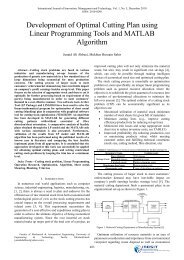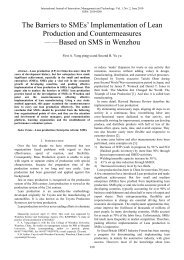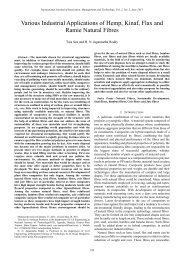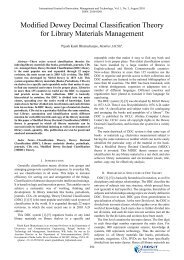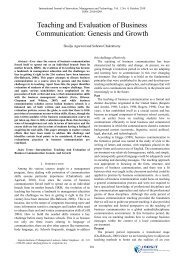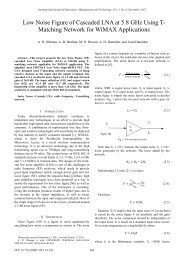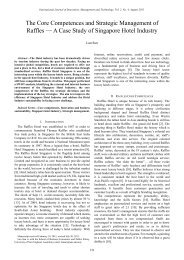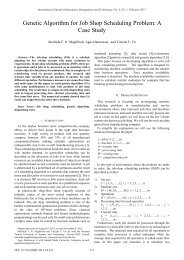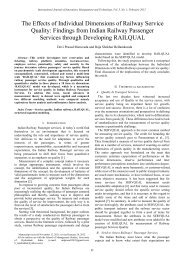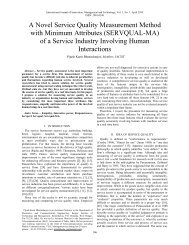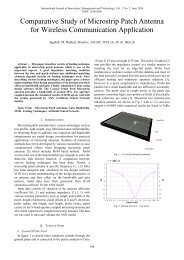Image Steganography Scheme using Chaos and Fractals with ... - ijimt
Image Steganography Scheme using Chaos and Fractals with ... - ijimt
Image Steganography Scheme using Chaos and Fractals with ... - ijimt
You also want an ePaper? Increase the reach of your titles
YUMPU automatically turns print PDFs into web optimized ePapers that Google loves.
International Journal of Innovation, Management <strong>and</strong> Technology, Vol. 3, No. 3, June 2012<br />
<strong>and</strong> W ( I ).<br />
Here W <strong>and</strong> W are determined by the key <strong>and</strong><br />
2 1<br />
2<br />
they may or may not be necessarily the same. One benefit of<br />
this design is to achieve a larger key space. Unless the correct<br />
wavelet mother function W is used, one cannot extract the<br />
1<br />
exact embedded secret information from a cover image;<br />
unless the correct wavelet mother function W is used, one<br />
2<br />
cannot restore the secret information from extracted secret<br />
information in the spatial domain.<br />
Stage I<br />
Stage II<br />
A<br />
DV<br />
Secret<br />
<strong>Image</strong> Ι<br />
W(Ι)<br />
A<br />
DV<br />
DWT<br />
W(SCb)<br />
DH<br />
DD<br />
DH<br />
DD<br />
Logistic<br />
Map<br />
Selecting<br />
Positions<br />
Energy<br />
Equalization<br />
Embedding Data<br />
IDWT<br />
Stage III<br />
W(CCb)<br />
SCb<br />
A<br />
DV<br />
DWT<br />
DH<br />
DD<br />
IYCbCr<br />
CCb<br />
Cover<br />
<strong>Image</strong> C<br />
YCbCr<br />
CCr<br />
CY<br />
Stego<br />
<strong>Image</strong> S<br />
Fig. 2. The flowchart of the proposed steganographic scheme.<br />
B. Stage II: Secret Data Embedding<br />
This stage is the core of the steganography. It embeds the<br />
transformed secret image W 2<br />
( I ) in the transformed cover<br />
image W ( C ) .<br />
1 Cb<br />
First, the initial value x <strong>and</strong> the parameter value r of the<br />
0<br />
logistic map in Eq. (9) are determined by the key. Based on<br />
the number of coefficients in W 2<br />
( I ) , the logistic map<br />
generates an equal length chaotic sequence Seq. However,<br />
this sequence Seq has to be quantized before used for<br />
extracting wavelet coefficients in W ( C ) . The number of<br />
1 Cb<br />
quantization scales N is calculated via Eq. (10), where<br />
#(.) computes the number of elements <strong>and</strong> dt . rounds the<br />
number towards to zero. Then Seq is quantized <strong>with</strong> respect<br />
to the bin numbers of the N equal-length bins in (0,1) ,<br />
namely<br />
⎛ 1 ⎤ ⎛k−1 k ⎤ ⎛ N −1<br />
⎞<br />
B = 0, , , B , , , B ,1<br />
1 ⎜ k<br />
N<br />
N<br />
⎥ = ⎜ =<br />
N N<br />
⎥ ⎜<br />
N<br />
⎟<br />
⎝ ⎦ ⎝ ⎦ <br />
⎝ ⎠<br />
Consequently, Seq is translated to a r<strong>and</strong>om-like sequence<br />
Seq composed of only numbers from 1 to N .<br />
N<br />
However Seq is still not the sequence which can be used<br />
N<br />
to extract wavelet coefficient in W ( C ) . Seq is calculated<br />
1 Cb<br />
N<br />
for partial sum <strong>and</strong> the Seq is obtained according to Eq. (11).<br />
c<br />
Seq is used to extract wavelet coefficients in W ( C ) . It is<br />
c<br />
1 Cb<br />
worthwhile to note that W ( C ) is composed of four regions<br />
1 Cb<br />
(see Fig. 2), namely approximation region A (passed by the<br />
low-pass filter along y <strong>and</strong> followed by the low-pass filter<br />
along x ), horizontal-details region DH(passed by the<br />
low-pass filter along y <strong>and</strong> followed by the high-pass filter<br />
along x ), vertical-details region VH(passed by the high-pass<br />
filter along y <strong>and</strong> followed by the low-pass filter along x ),<br />
<strong>and</strong> diagonal-details DD (passed by the high-pass filter along<br />
y <strong>and</strong> followed by the high-pass filter along x ). We keep<br />
region A but choose to substitute coefficients in DH, DV <strong>and</strong><br />
DD by the wavelet coefficients of W ( I ) . This is the reason<br />
2<br />
why Eq. (10) contains a factor of 3/4. In fact, the region A<br />
can be considered as the DC component of the image C .<br />
Cb<br />
Any change in this DC component may lead to big changes in<br />
the future. However, DH, DV <strong>and</strong> DD are more or less about<br />
the edge strength of C . Fractal cover images normally have<br />
Cb<br />
a large number of edges <strong>and</strong> rely on the DC component of the<br />
image to have the fractal-like patterns.<br />
⎢ 3 × #( C Cb<br />
) ⎥<br />
N = ⎢ ⎥<br />
(10)<br />
⎣ 4 × #( W ( I))<br />
2 ⎦<br />
k<br />
Seq ( k) = ∑ Seq ( k)<br />
(11)<br />
c<br />
i=<br />
1<br />
N<br />
The selected coefficients in W ( C ) are uniquely determined<br />
1 Cb<br />
by Seq <strong>and</strong> we named the set of the chosen coefficients as<br />
c<br />
P . Eq. (12) is used as the ratio of energy in set X to that in<br />
set Y , where E(.)<br />
represents the energy function.<br />
2<br />
EX ( ) x<br />
RXY ( , ) = 2<br />
EY ( )<br />
= ∑<br />
∑ (12)<br />
y<br />
We then compute L = R( P, W ( I))<br />
<strong>and</strong> lift wavelet<br />
2<br />
coefficients correspondingly, Consequently, the lifted energy<br />
LE( W ( I )) approximately match the energy of the original<br />
2<br />
EP ( ). Finally, we call these modified wavelet coefficients<br />
W ( S ) .<br />
1 Cb<br />
C. Stage III: Transforming <strong>Image</strong> Back to Spatial Domain<br />
Parallel to the Stage I, the main task of the Stage III is to<br />
inverse transform everything in the wavelet domain to the<br />
spatial domain.<br />
W ( S ) is inverse wavelet transformed to the spatial<br />
1 Cb<br />
domain <strong>and</strong> becomes the image S Cb<br />
. The S Cb<br />
is used to<br />
replace the original Cb component C Cb<br />
for the color cover<br />
image C .<br />
Eventually, the component set { C , S , C } is converted<br />
Y Cb Cr<br />
from the YCbCr color space to the RGB color space.<br />
IV. SIMULATION RESULTS AND DISCUSSION<br />
Our computer simulation is run in the MATLAB R2009a<br />
environment under Window XP operation system <strong>with</strong> 3GB<br />
memory <strong>and</strong> Core 2 Quad 2.6GHz CPU.<br />
The key we used in the simulation has the format of<br />
{ x , r, width, height, db #, db #}, where x <strong>and</strong> r are used in<br />
0<br />
C I<br />
0<br />
the logistic map for generating the embedding/ extracting<br />
positions; width <strong>and</strong> height are used to reform the rebuilt<br />
287



